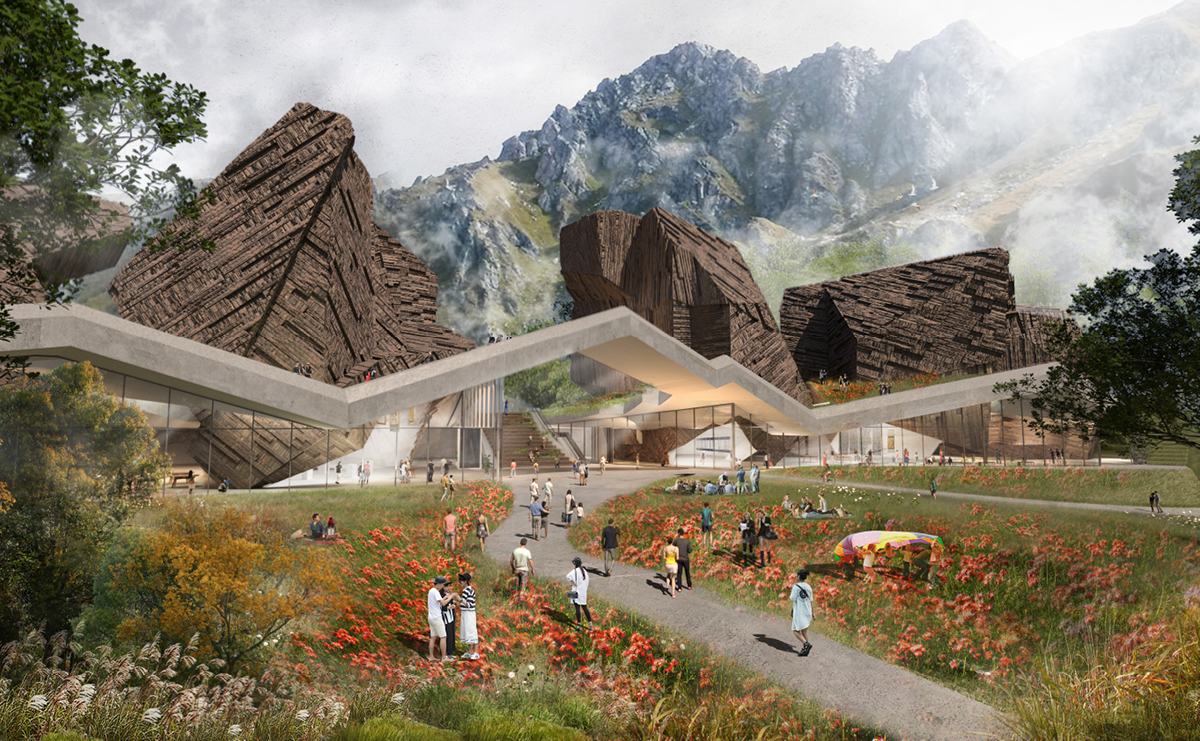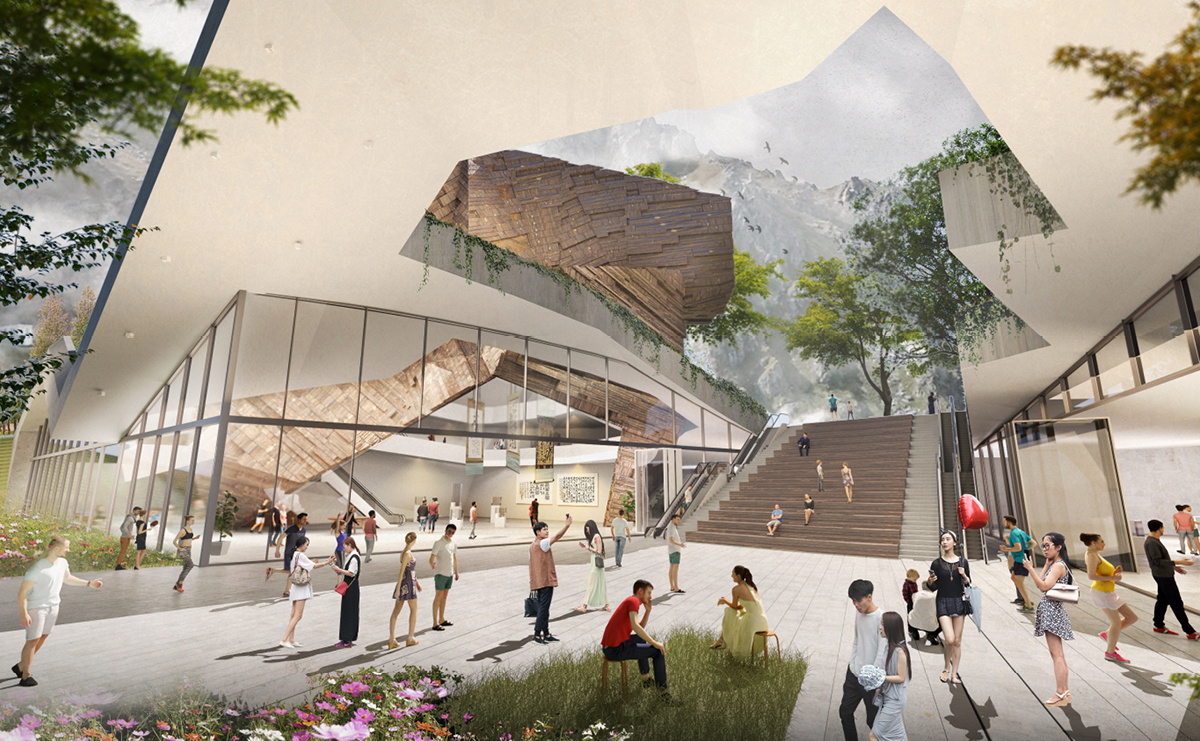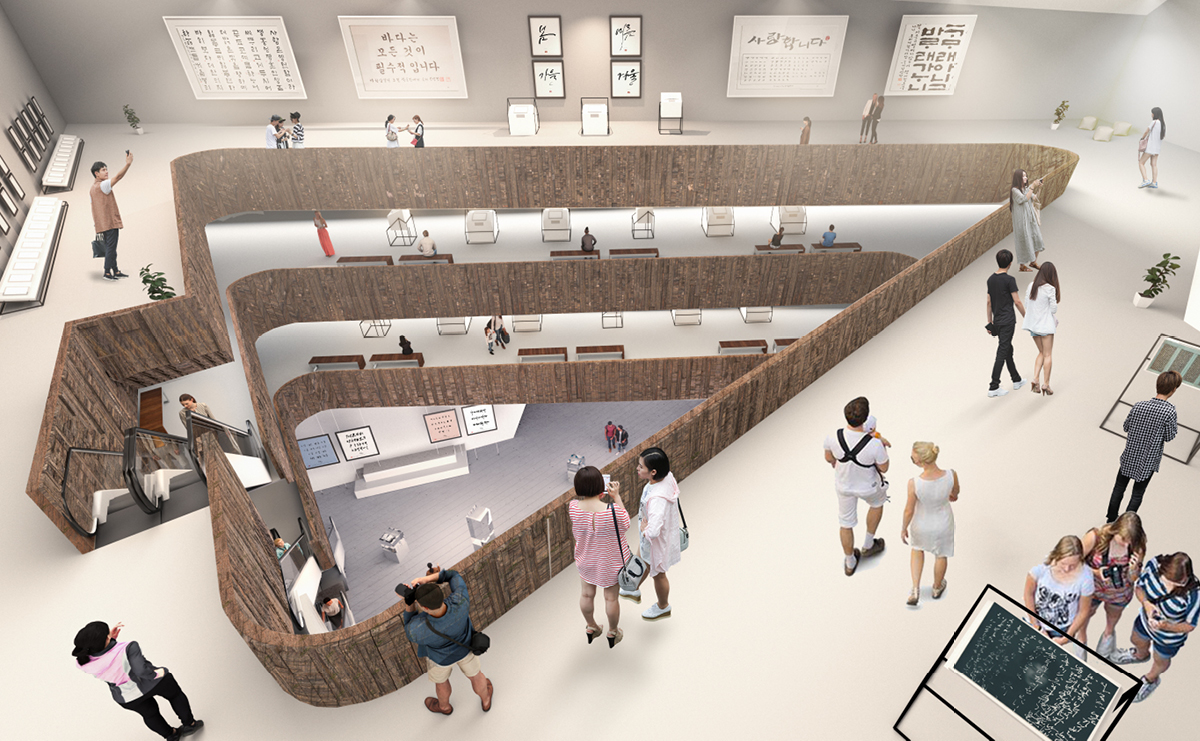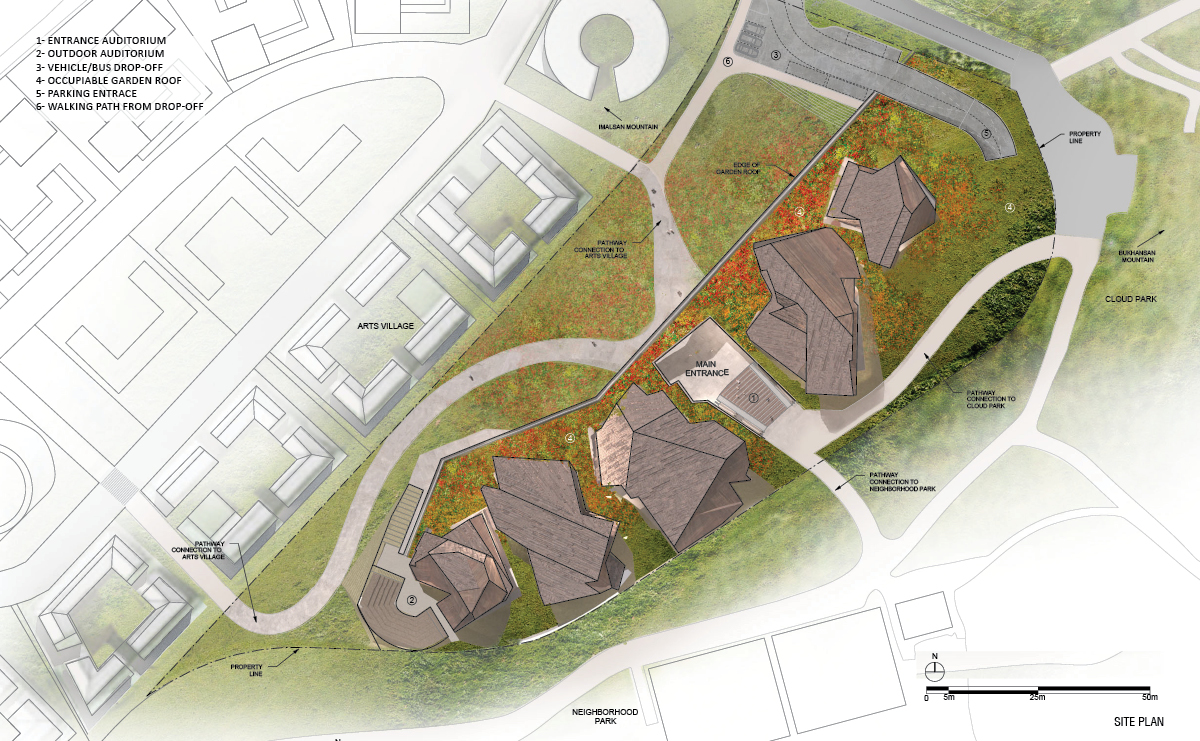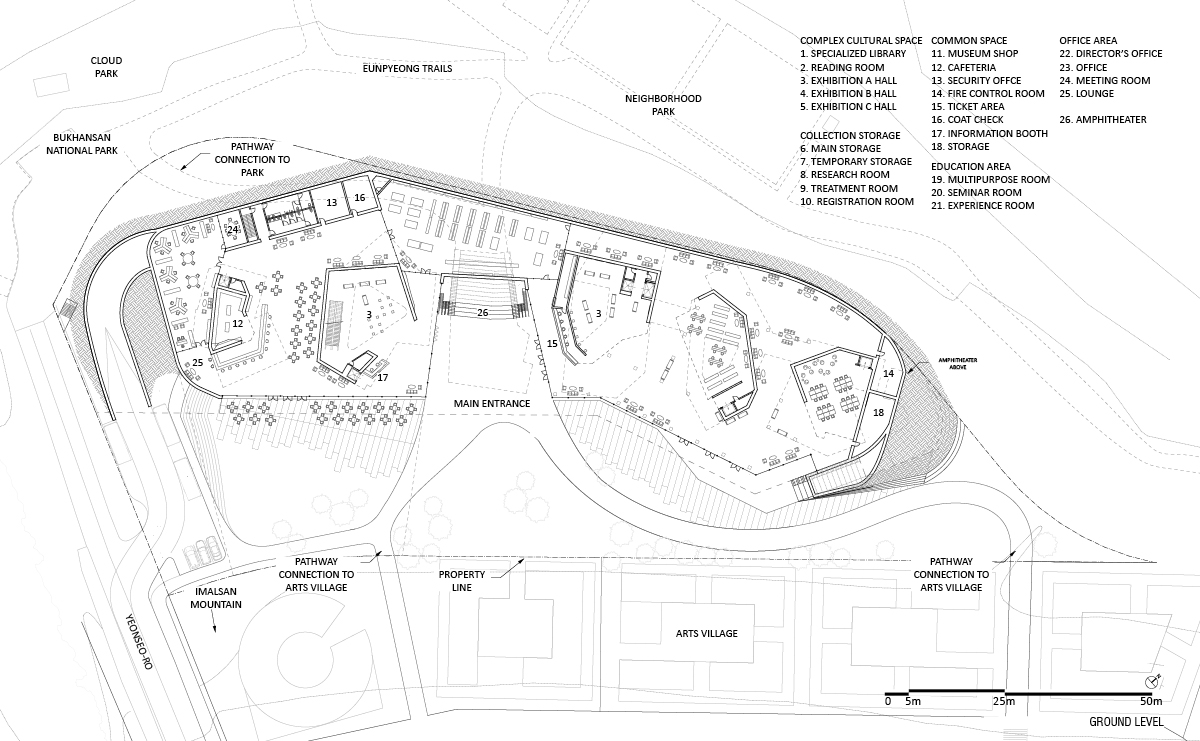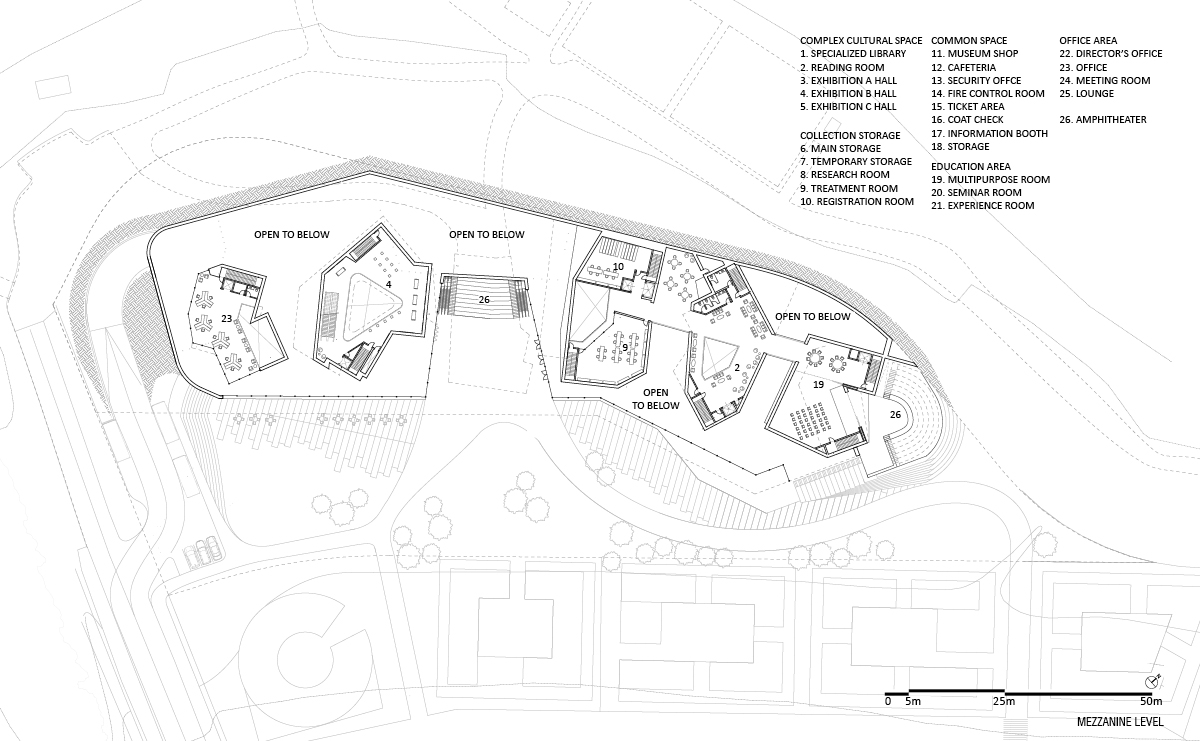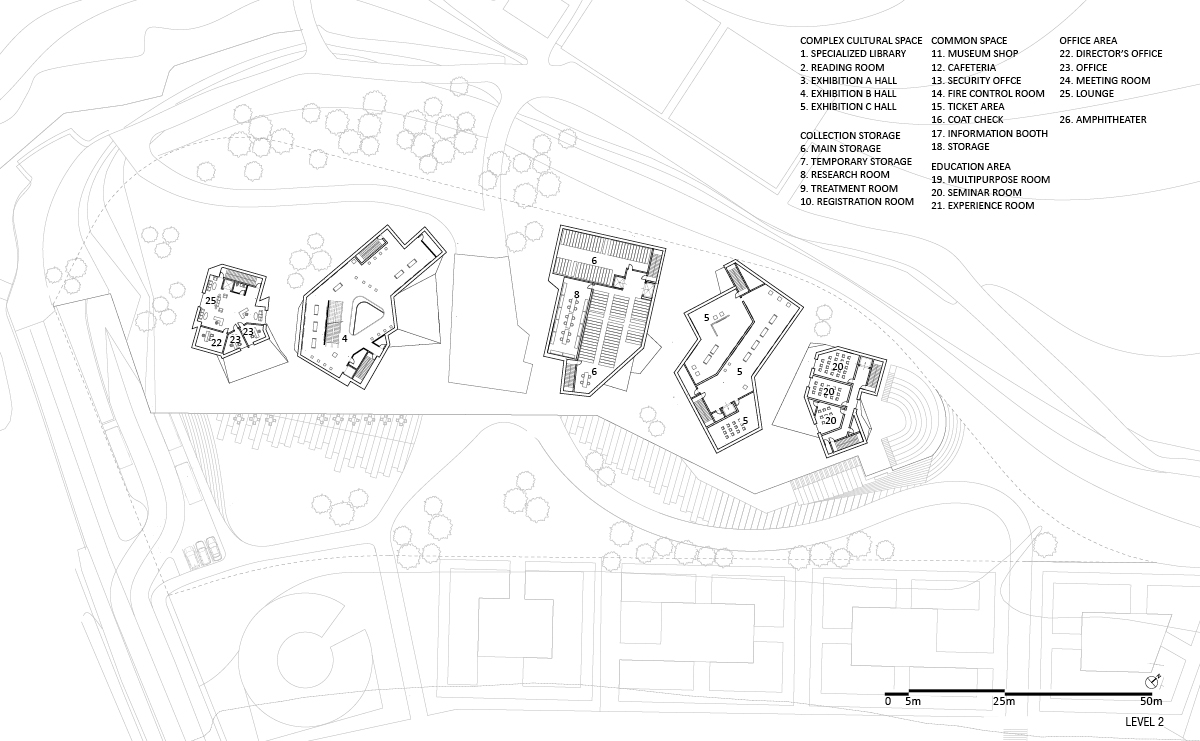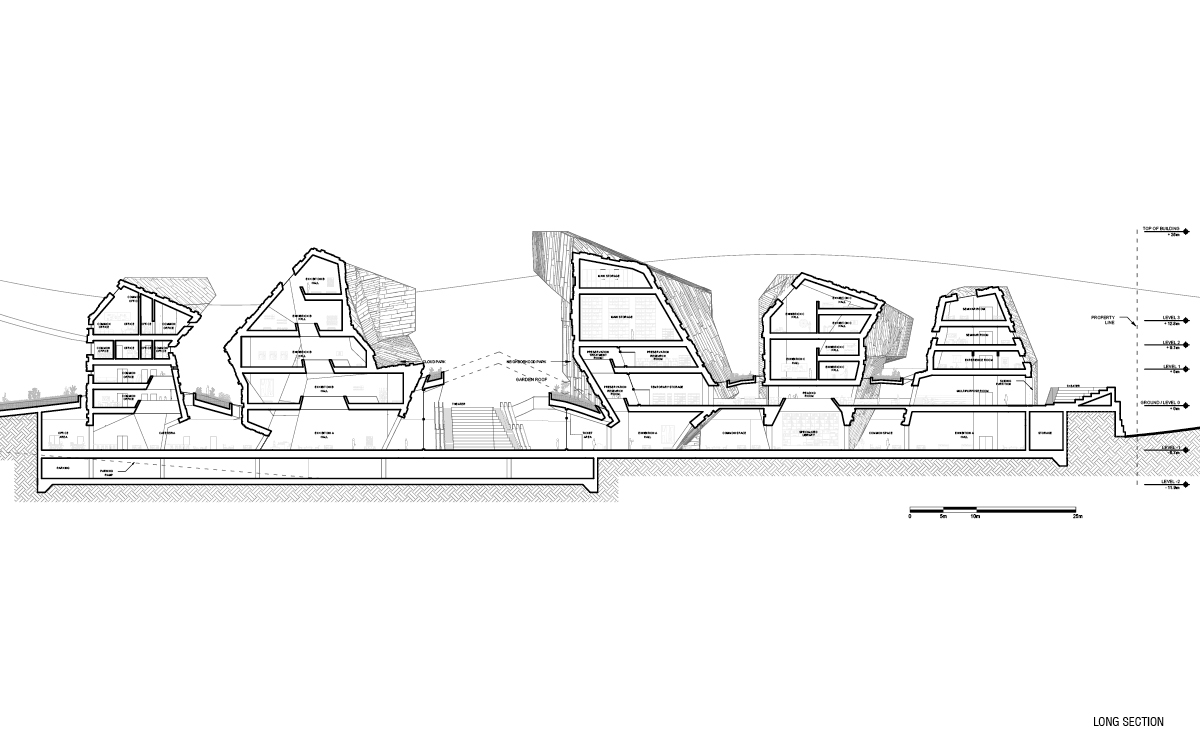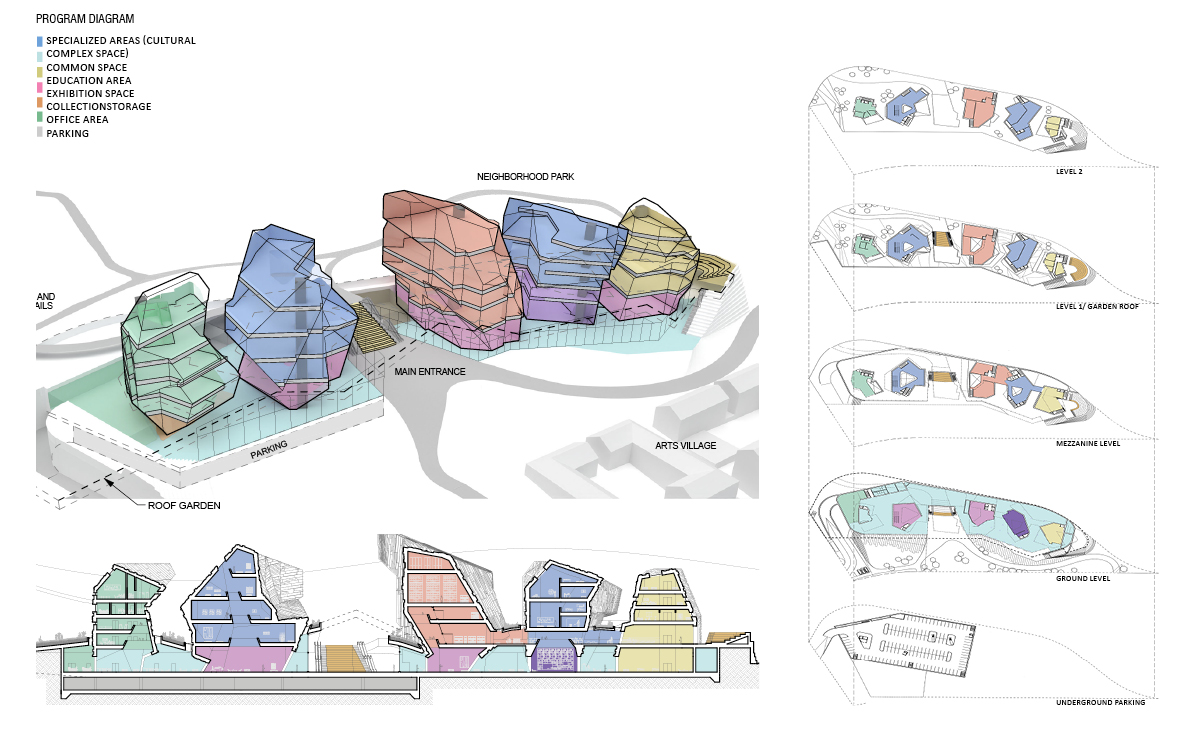Mountains & Meadows
Client: City of Seoul
Program: Museum of Literature
Size: 111,000 SqFt
Completion Date: 2021
Material: Concrete, Glass, Steel, CLT
Architect: Baumgartner + Uriu, llp
Team: Garrett Sutherlin Santo, Charles Allen, Stella Buckmann, Kait Cartmell, Aiden Ko, Lilith Swan
Mountains & Meadows
National Museum of Korean Literature
Pillars in the landscape- design overview
The design is inspired by Bukhansan mountain where the soft landscape with its lush and colorful vegetation nestles between its rocky mountain tops. This dichotomy of the hard rocky peaks and the soft mountain terrain became the concept for the building design. We wanted the building to have a harmonious relationship with the surrounding landscape. The building massing consist of a large green roof that blends into the existing terrain and five pillar-like masses that are imbedded into the roof landscape. The pillars are spaced apart so you can always view the mountains between the building masses. The roof lifts up and opens towards the Art Village; Enclosed with a glass façade, the common space underneath is organized as an open plan that freely flows around the pillars connecting them and providing scenic views into the surrounding landscapes. The pillars are 3-4 stories tall and are sliced open at base level, allowing access to the different programmatic elements including exhibition spaces, library, education and research facilities, offices, and the collection storage spaces.
The walkable green roof creates abundant outdoor spaces around the pillars with direct access from some of the program inside including the multipurpose room that opens up into an outdoor amphitheater on the south end of the project. Glass skylights bridge the gap between the pillars and the green roof allowing for natural daylight to enter and brighten up the common areas below.
The Hub - Site connectivity
The Hub is at the center of the building and is not only the Main Entry point into the museum, it also connects the art village to the west with the neighborhood park of Gijachon district 1 to the east through a pedestrian walkway. Where it crosses the museum, the walkway turns into an outdoor amphitheater flanked by stairs and escalators on either site. One can move through this space without having to enter the museum but gets a glimpse of the activity inside. The outdoor seating area doubles as a shaded hang out space for the visitors and as an outdoor performance space for concerts and lectures. The exhibition space can be expanded to the outside with foldable glass doors. Directly adjacent to the main entry of the museum the Hub harmoniously connects indoor and outdoor spaces into a single environment and lets nature flow through the building.
The Ancient and the New- materiality
A wood façade inspired by ancient Korean print making. We wanted to connect the materiality, color and texture of the museum with its content and looked at the art of print making and its very beginnings. Print making was invented in Korea and not in Germany as many falsely believe. Jikji was the first printed book using movable metal type. It was published in Heungdeck temple in 1377 almost 80 years before the Gutenbergs Bible was printed.
Printing gives paper a new dimensionality, it gives it thickness, a texture that you can see, feel and touch. We wanted to transform this idea into a building envelope and chose wood, the base material for paper, to create textured CLT (cross laminated timber) panels to make the building envelope. The CLT panels are layered and three dimensional and are inspired by the metal type used to print the first book – the Jikji. Textured wood panels are also used selectively on the interior to highlight certain architectural elements and to bring warmth into the spaces they are set in contrast to the white museum walls.
The Meadow- landscape design
The concept for the landscape design is to create a seamless transition into the natural surroundings by designing a Meadow that connects Gijachon park with the art village. The green roof will be part of this meadow sprinkled with small groups of trees for shade and picknicks. We propose to pick exclusively native plants, flowers and trees that will complement the natural context. That foliage will be selected to create specific color pallets for the spring, summer and fall. The meadow will flow over the green roof and through the building creating a symbiotic relations ship between natural and built environment.
Pillars in the landscape- design overview
The design is inspired by Bukhansan mountain where the soft landscape with its lush and colorful vegetation nestles between its rocky mountain tops. This dichotomy of the hard rocky peaks and the soft mountain terrain became the concept for the building design. We wanted the building to have a harmonious relationship with the surrounding landscape. The building massing consist of a large green roof that blends into the existing terrain and five pillar-like masses that are imbedded into the roof landscape. The pillars are spaced apart so you can always view the mountains between the building masses. The roof lifts up and opens towards the Art Village; Enclosed with a glass façade, the common space underneath is organized as an open plan that freely flows around the pillars connecting them and providing scenic views into the surrounding landscapes. The pillars are 3-4 stories tall and are sliced open at base level, allowing access to the different programmatic elements including exhibition spaces, library, education and research facilities, offices, and the collection storage spaces.
The walkable green roof creates abundant outdoor spaces around the pillars with direct access from some of the program inside including the multipurpose room that opens up into an outdoor amphitheater on the south end of the project. Glass skylights bridge the gap between the pillars and the green roof allowing for natural daylight to enter and brighten up the common areas below.
The Hub - Site connectivity
The Hub is at the center of the building and is not only the Main Entry point into the museum, it also connects the art village to the west with the neighborhood park of Gijachon district 1 to the east through a pedestrian walkway. Where it crosses the museum, the walkway turns into an outdoor amphitheater flanked by stairs and escalators on either site. One can move through this space without having to enter the museum but gets a glimpse of the activity inside. The outdoor seating area doubles as a shaded hang out space for the visitors and as an outdoor performance space for concerts and lectures. The exhibition space can be expanded to the outside with foldable glass doors. Directly adjacent to the main entry of the museum the Hub harmoniously connects indoor and outdoor spaces into a single environment and lets nature flow through the building.
The Ancient and the New- materiality
A wood façade inspired by ancient Korean print making. We wanted to connect the materiality, color and texture of the museum with its content and looked at the art of print making and its very beginnings. Print making was invented in Korea and not in Germany as many falsely believe. Jikji was the first printed book using movable metal type. It was published in Heungdeck temple in 1377 almost 80 years before the Gutenbergs Bible was printed.
Printing gives paper a new dimensionality, it gives it thickness, a texture that you can see, feel and touch. We wanted to transform this idea into a building envelope and chose wood, the base material for paper, to create textured CLT (cross laminated timber) panels to make the building envelope. The CLT panels are layered and three dimensional and are inspired by the metal type used to print the first book – the Jikji. Textured wood panels are also used selectively on the interior to highlight certain architectural elements and to bring warmth into the spaces they are set in contrast to the white museum walls.
The Meadow- landscape design
The concept for the landscape design is to create a seamless transition into the natural surroundings by designing a Meadow that connects Gijachon park with the art village. The green roof will be part of this meadow sprinkled with small groups of trees for shade and picknicks. We propose to pick exclusively native plants, flowers and trees that will complement the natural context. That foliage will be selected to create specific color pallets for the spring, summer and fall. The meadow will flow over the green roof and through the building creating a symbiotic relations ship between natural and built environment.

